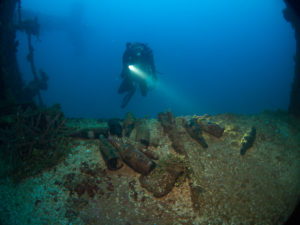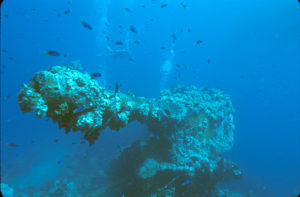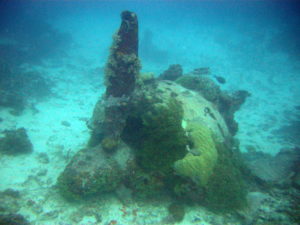Chuuk Lagoon (also known as Truk Lagoon) in Micronesia is one of the diving world’s most revered destinations. But with so much to choose from, how do divers know which are the best dive sites in Chuuk Lagoon? First, a little history.
On February 17, 1944, U.S. Navy carrier aircraft conducted Operation Hailstone, a surprise attack against Japanese ships anchored in the lagoon. The Navy dropped over 440 tons of bombs and torpedoes on the fleet, sinking 40 ships and killing thousands of Japanese soldiers. By the end of the operation, 16 warships and 32 merchant ships lay at the bottom of the lagoon. More than 250 Japanese aircraft were destroyed as well.
Although it’s easy to become overwhelmed in Chuuk, both by the scale of destruction and the sheer number of sites, it’s the perfect destination for a history buff or tech diver. Depths on some sites can exceed 200 feet, but nonetheless many sites are accessible to recreational divers as well. Micronesia offers good diving year-round, with daily temperatures ranging from 80 to 90 F (25 to 31 C). The sheltered waters of Chuuk Lagoon mean very little current. Water temperatures hover between 83 and 85 F (28 and 29 C). Visibility is usually between 40 and 100 feet. With that said, here are our picks for the very best dive sites in Chuuk Lagoon.

Rio de Janeiro Maru
Around 450 yards from the shore on the east side of Uman Island lies the Rio de Janeiro Maru, a passenger liner that went down during Operation Hailstone. It still has a well-preserved stern gun, large propellers, posts and long companionways to explore. Wreck-qualified divers can access the engine room inside the wreck, as well as the many holds littered with unopened beer bottles and gun barrels. This dive, like all dives in Chuuk Lagoon, are guided dives so as to comply with local diving laws and regulations.
Depth: 40 to 110 feet (12 to 33 m)
The I-169 “Shinoharu” submarine
The I-169 “Shinohara” submarine participated in the attack on Pearl Harbor, later coming to Truk Lagoon to replenish two Japanese ships. One evening, anchored at Truk with senior officers ashore, juniors aboard received word of a false U.S. air raid and were ordered to dive to the floor for protection. In their rush, they forgot to close the control-room ventilators, and the boat quickly flooded once submerged. After multiple attempts to raise the sub failed, the entire crew suffocated to death except for the captain, Shigeo Shinoharu, who was not aboard at the time. Once they realized they could not recover the sub, the Japanese gave the order to destroy it to avoid U.S. recovery.
Rediscovered in 1973, the wreck lies in around 89 feet (27 m) of water. Hundreds of jellyfish seem to surround the submarine, along with turtles and the occasional ray or shark. You cannot penetrate the submarine due to the tight squeeze, but diving around it is not to be missed.
Depth: 90 to 140 feet (27 to 43 m)

Fujikawa Maru
Sunk by a single aerial torpedo and a favorite among divers, the Fujikawa Maru’s magnificent gun still takes pride of place on this wreck, which tops every list of best dive sites in Chuuk Lagoon. Live corals and clouds of fish engulf the ship, and galleys, staterooms and baths are all easily accessible. Even with all these treasures, perhaps the wreck’s most spectacular feature is the Zero aircraft, still in its hold.
Depth: 15 to 120 feet (5 to 37 m)
San Francisco Maru
The most famous of all the shipwrecks in Chuuk Lagoon, the San Francisco Maru sits completely upright with a bow gun, tanks, mines and even trucks still fully intact. It’s one of Chuuk’s deepest wrecks, with the deck at 140 feet (42 m) and the hull at 210 feet (64 m). Although there’s not much to see when it comes to marine life, there are two large trucks in hold No. 2. The other holds are filled with interesting artifacts such as crates, artillery shells, fuel drums, airplane engines and aircraft bombs. Keep the depth in mind as you plan the day’s dives. This wreck is suitable only for the most experienced divers or tec divers.
Depth: 140 feet to 210 feet (42 m to 64 m)

Betty Bomber
This Japanese Navy bomber first flew in 1939 with the nickname the “flying cigar,” which referred to the way it would light up when it fired its guns. Betty was supposed to land at the Eten Island airport, but went down a few hundred feet shy of the airstrip. The plane lost its nose, starboard wingtip and engines in the process. Divers can still find these artifacts around 325 feet (100 m) away from the wreck today, along with schools of batfish that will follow you on your way. This shallow wreck is perfect for every diver, and especially makes a good afternoon dive, if you’ve gone deep in the morning.
Depth: 65 feet (19 m)
Guest author Sarah Richard is a travel writer currently living in Hong Kong. She is a divemaster who has been diving for eight years and has most recently worked on a liveaboard in Micronesia. She also runs her own travel blog here.

